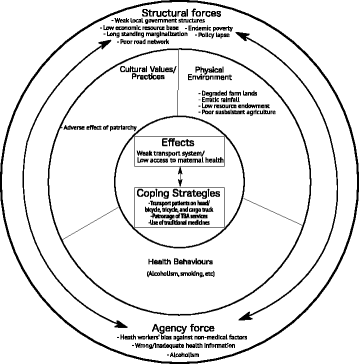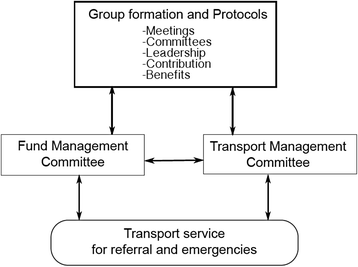Can she make it? Transportation barriers to accessing maternal and child health care services in rural Ghana
- PMID: 26290436
- PMCID: PMC4545969
- DOI: 10.1186/s12913-015-1005-y
Can she make it? Transportation barriers to accessing maternal and child health care services in rural Ghana
Abstract
Background: The Ghana Community based Health Planning and Services (CHPS) strategy targets to bring health services to the doorsteps of clients in a manner that improves maternal and child health outcomes. In this strategy, referral is an important component but it is threatened in a rural context where transportation service is a problem. Few studies have examined perceptions of rural dwellers on transportation challenges in accessing maternal health care services within CHPS.
Methods: Using the political ecology of health framework, this paper investigates transportation barriers in health access in a rural context based on perceived cause, coping mechanisms and strategies for a sustainable transportation system. Eight (8) focus group discussions involving males (n = 40) and females (n = 45) in rural communities in a CHPS zone in the Upper West Region of Ghana were conducted between September and December 2013.
Results: Lack of vehicular transport is suppressing the potential positive impact of CHPS on maternal and child health. Consistent neglect of road infrastructural development and endemic poverty in the study area makes provision of alternative transport services for health care difficult. As a result, pregnant women use risky methods such as bicycle/tricycle/motorbikes to access obstetric health care services, and some turn to traditional medicines and traditional birth attendants for maternal health care services.
Conclusion: These findings underscore the need for policy to address rural transport problems in order to improve maternal health. Community based transport strategy with CHPS is proposed to improve adherence to referral and access to emergency obstetric services.
Figures
References
-
- Leipziger D, Fay M, Wodon Q, Yepes T. Achieving the Millennium Development Goals: The Role of Infrastructure. 2003.
-
- Galaa S, Daare K. Understanding barriers to maternal child health services utilisation in northern Ghana. J Soc Dev Afr. 2008;23(2):127–155.
MeSH terms
LinkOut - more resources
Full Text Sources
Other Literature Sources
Medical
Research Materials



